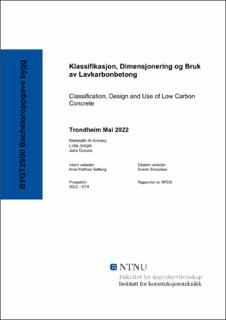| dc.contributor.advisor | Selberg, Arne Mathias | |
| dc.contributor.advisor | Smeplass, Sverre | |
| dc.contributor.author | Al-Anbary, Mohtadin | |
| dc.contributor.author | Gucwa, Julia | |
| dc.contributor.author | Jiorgio, Lidia | |
| dc.date.accessioned | 2022-07-02T17:19:18Z | |
| dc.date.available | 2022-07-02T17:19:18Z | |
| dc.date.issued | 2022 | |
| dc.identifier | no.ntnu:inspera:106805903:106989269 | |
| dc.identifier.uri | https://hdl.handle.net/11250/3002350 | |
| dc.description.abstract | Betong er et uerstattelig byggemateriale, med sine gode egenskaper har det funnet anvendelse ved bygg, lands- og marinekonstruksjoner. Byggebransjen er dermed ansvarlig for 40% av de menneskeskapte CO2 utslippene globalt. Sementproduksjonen står for omtrent 7-8% av disse utslippene. Evnen til å lykkes med å nå FNs bærekraftsmål avhenger av å finne bærekraftige metoder for fremskaffelse av byggematerialer, eksempelvis sement som brukes til å produsere betong.
Lavkarbonbetong er utarbeidet som et forsøk på å redusere sementinnholdet i betongblandingen. Denne oppgaven tar for seg eventuelle utfordringer ved overgang og bruk av denne. Materialene valgt som tilsetning i sementen har ulik tilgjengelighet, og påvirker både karbonregnskapet og betongens egenskaper. Derfor vil mengden og typen av slike materialer påvirke klassifisering og bruk av lavkarbonbetong. Dimensjonering har en stor rolle for karbonregnskapet, men ettersom lavkarbonbetong har de samme styrkeegenskapene som betong vil disse dimensjoneres likt.
Skanska Norge er en ledende entreprenør, og har vist initiativ om å starte i gang med det grønne skiftet. Norges største nybygde powerhouse i Trondheim er en inspirasjon, og Nidarvollprosjektene følger trenden. Skanska benyttet hovedsaklig lavkarbonbetong som byggemateriale i Nidarvollprosjektene, både konstruksjonselementer og plasstøpt, derfor er det et perfekt prosjekt å analysere i lys av utfordringer og tiltak som benyttes.
Trondheim kommune som er byggherren, har satt miljøkrav om å redusere utslippene med 30% i forhold til et referansebygg. Nidarvollprosjektene har derfor tatt i bruk flere klimareduserende tiltak. Det inkluderer bruk av lavkarbonbetong, gjenvinning og gjenbruk av materialer fra tidligere konstruksjon og drift av en fossilfri byggeplass.
Implementering av disse sammen med optimaliseringer gjort for energieffektivitet sparte prosjektet for ca. 50% av klimagassutslippene.
Foreløpig er Skanska eneste som forespørr lavkarbonbetong fra betong- og elementleverandørene Unicon og Con-Form. Derfor er det gjort befaringer til både nidarvollprosjektene, betongfabrikken og elementleverandøren for å samle opplevelsene og utfordringene knyttet opp mot lavkarbonbetong.
Denne betongen er foreløpig ikke kostnadseffektiv, og uten insentiver og kunnskap vil ikke de fleste entreprenørene påføre seg den ekstra tiden og kostnadene bruken medfører. Derfor må det utføres tiltak slik at de små bedriftene tas med i den grønne utviklingen. | |
| dc.description.abstract | Concrete is an irreplaceable construction material, it's great properties have let it find use in buildings, land- and marine constructions. The construction industry is thus also responsible for 40% of man-made CO2 emissions globally. Cement production is responsible for approximately 7-8% of these and is often linked to concrete as it accounts for as much as 90\% of the emissions. Thus, the ability to successfully reach the UN sustainability goal depends on finding sustainable methods for obtaining construction materials, such as cement which is utilized in concrete production.
Low-carbon concrete has been developed as an attempt to reduce the cement content in the concrete. This thesis' immediate objective is to put light on the challenges that the transition and use cause. The materials chosen as additives in the cement have different availability and affect both the global warming potential and the properties of the concrete. Therefore, the amount and type of such materials will affect the classification and use of low-carbon concrete. Design plays a major role in the total emissions, but due to the same strength properties as traditional concrete, the design process is the same.
Skanska Norway is a leading contractor, and has shown initiative to start the green shift. Norway's largest newly built powerhouse in Trondheim is an inspiration, and the Nidarvollproject are following the trend. Skanska mainly used low-carbon concrete as a construction material in the Nidarvollproject, both the elements and cast-in-place, therefore it is a perfect project to analyze in light of the challenges and measures used.
Trondheim municipality which is the client has set environmental requirements to reduce emissions by 30% in regard to an equal reference. The Nidarvollproject have therefore implemented several climate-reducing measures. That includes the use of low-carbon concrete, recycling and reuse of materials from the previous construction, and operation of a fossil-free construction site. Implementing these together with optimizations made for energy efficiency saved the projects approx. 50% of the emissions.
Currently, Skanska is the only company to request low-carbon concrete from the concrete- and element suppliers Unicon and Con-Form. Hence, visits have been made to the Nidarvollproject, concrete factory Unicon, and element supplier Con-From to gather experiences and challenges associated with low-carbon concrete.
This concrete is currently not very cost-effective, and without incentives and knowledge, most contractors will not incur the extra time and costs the use entails. Therefore, measures must be taken so that small companies are included in the green development. | |
| dc.language | nob | |
| dc.publisher | NTNU | |
| dc.title | Klassifikasjon, dimensjonering og bruk av lavkarbonbetong | |
| dc.type | Bachelor thesis | |
